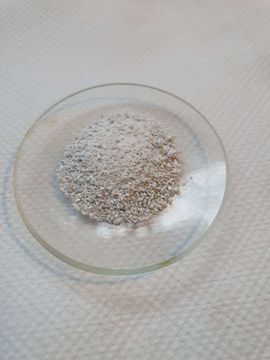Difference between revisions of "Calcium hydride"
| Line 7: | Line 7: | ||
| OtherNames = Calcium(II) hydride<br>Calcium dihydride | | OtherNames = Calcium(II) hydride<br>Calcium dihydride | ||
<!-- Images --> | <!-- Images --> | ||
| − | | ImageFile = | + | | ImageFile = Calcium hydride CaH2 sample by Ormarion.jpg |
| − | | ImageSize = | + | | ImageSize = 270 |
| ImageAlt = | | ImageAlt = | ||
| ImageName = | | ImageName = | ||
| + | | ImageCaption = CaH<sub>2</sub> granules | ||
| ImageFile1 = | | ImageFile1 = | ||
| ImageSize1 = | | ImageSize1 = | ||
Latest revision as of 17:58, 13 January 2024
 CaH2 granules
| |
| Names | |
|---|---|
| IUPAC name
Calcium hydride
| |
| Other names
Calcium(II) hydride
Calcium dihydride | |
| Identifiers | |
| Jmol-3D images | Image |
| |
| Properties | |
| CaH2 | |
| Molar mass | 42.094 g/mol |
| Appearance | White (pure) or gray (impure) powder |
| Density | 1.70 g/cm3 |
| Melting point | 816 °C (1,501 °F; 1,089 K) |
| Boiling point | Decomposes |
| Reacts | |
| Solubility | Reacts with alcohols, carboxylic acids Insoluble in common solvents |
| Vapor pressure | ~0 mmHg |
| Thermochemistry | |
| Std molar
entropy (S |
41.4 J·mol−1·K−1 |
| Std enthalpy of
formation (ΔfH |
−181.5 kJ·mol−1 |
| Hazards | |
| Safety data sheet | ApolloScientific |
| Related compounds | |
| Related compounds
|
Lithium hydride Sodium hydride |
| Except where otherwise noted, data are given for materials in their standard state (at 25 °C [77 °F], 100 kPa). | |
| Infobox references | |
Calcium hydride is the chemical compound with the formula CaH2, widely used as a drying agent, especially in drying solvents.
Contents
Properties
Chemical
Calcium hydride reacts with water to release hydrogen gas:
- CaH2 + H2O → Ca(OH)2 + H2 ↑
Physical
Calcium hydride is a grey or white solid powder, insoluble in all solvents. It reacts vigorously with water and alcohols. CaH2 has a density of 1.70 g/cm3.
Availability
CaH2 is sold by various chemical suppliers.
Preparation
Calcium hydride can be made by reacting dry hydrogen gas with calcium metal at temperatures between 300 to 400 °C.
Projects
- Dry solvents
- Readily hydrogen source
Handling
Safety
Calcium hydride reacts with water, releasing flammable hydrogen gas.
Storage
Calcium hydride is best stored in closed and airtight containers.
Disposal
A simple way of neutralizing calcium hydride is to add it slowly in a large volume of water, in a well ventilated area. A slower, but safer way is to expose calcium hydride to water vapors. Instead of water, long chain alcohols can also be used to neutralize this compound.
References
Relevant Sciencemadness threads
- Chemical pages without CAS Registry Number
- Articles without EBI source
- Chemical pages without ChemSpiderID
- Chemical pages without DrugBank identifier
- Articles without KEGG source
- Articles without InChI source
- Articles without UNII source
- Articles containing unverified chemical infoboxes
- Chemical compounds
- Inorganic compounds
- Calcium compounds
- Hydrogen compounds
- Metal hydrides
- Bases
- Insoluble compounds
- Reducing agents
- Desiccants
- Materials unstable in acidic solution
- Materials that react with water
- Irritants
- Air-sensitive materials
- Solids